What you need to know in case disaster hits Sonoma County
The threat of natural disaster is often looming in the North Bay. From wildfires to earthquakes, we've compiled a comprehensive list of what you need to be prepared.
How to get news during outages/disasters
Overall preparedness kit
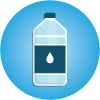 Bring one gallon of water per person per day to stay hydrated in case of disrupted or contaminated water supplies. If you are evacuating your house, bring at least a three-day supply, according to the American Red Cross.
Bring one gallon of water per person per day to stay hydrated in case of disrupted or contaminated water supplies. If you are evacuating your house, bring at least a three-day supply, according to the American Red Cross.
Pack nonperishable and easy-to-prepare food items, such as canned foods or dry mixes, according to Ready.gov. Make sure they are not spicy or salty, which often cause increased thirst. Bring a can opener, utensils or containers if needed.
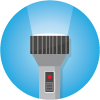 Have a flashlight on hand, according to the Red Cross, in case the emergency occurs in the dark or in a power outage. Flashlights will allow you remain aware of your surroundings in these scenarios.
Have a flashlight on hand, according to the Red Cross, in case the emergency occurs in the dark or in a power outage. Flashlights will allow you remain aware of your surroundings in these scenarios.
 Purchase or pack a battery-powered or hand-crank radio, according to the Red Cross. A weather alert radio is best, according to Midland USA, because they'll notify you with updates regardless of the station you are listening to or if the power is on. The Red Cross encourages radios that can provide NOAA Weather Radio Alerts.
Purchase or pack a battery-powered or hand-crank radio, according to the Red Cross. A weather alert radio is best, according to Midland USA, because they'll notify you with updates regardless of the station you are listening to or if the power is on. The Red Cross encourages radios that can provide NOAA Weather Radio Alerts.
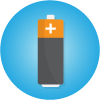 Bring extra batteries that provide power for your flashlight, battery-powered radio or phone charger. If you lose electricity, these devices need to be reliable throughout the emergency.
Bring extra batteries that provide power for your flashlight, battery-powered radio or phone charger. If you lose electricity, these devices need to be reliable throughout the emergency.
 A first aid kit with proper medical supplies is an absolute necessity in case of injury or medical issues. Essentials include moleskin fabric, liquid bandages, soft-wrap elastic bandages, micro pore paper tape, fabric adhesive dressings and various bandages, non-adherent bandage pads, a sterile gauze bandage roll, adhesive wound closures, triangular bandages, alcohol swabs and antiseptic wipes, packets of antibiotic ointment, burn ointment, eye wash, a thermometer, petroleum jelly, pain relievers, anti-diarrheal medications, antacids and laxatives, according to the New York Times and Frank Smyth, the executive director of Global Journalist Security.
A first aid kit with proper medical supplies is an absolute necessity in case of injury or medical issues. Essentials include moleskin fabric, liquid bandages, soft-wrap elastic bandages, micro pore paper tape, fabric adhesive dressings and various bandages, non-adherent bandage pads, a sterile gauze bandage roll, adhesive wound closures, triangular bandages, alcohol swabs and antiseptic wipes, packets of antibiotic ointment, burn ointment, eye wash, a thermometer, petroleum jelly, pain relievers, anti-diarrheal medications, antacids and laxatives, according to the New York Times and Frank Smyth, the executive director of Global Journalist Security.
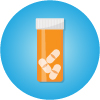 Bring a seven-day supply of necessary medications and prescriptions, as well as additional medical items such as spare glasses, sanitary towelettes, tweezers and scissors to use in combination with your first aid kit, according to the New York Times.
Bring a seven-day supply of necessary medications and prescriptions, as well as additional medical items such as spare glasses, sanitary towelettes, tweezers and scissors to use in combination with your first aid kit, according to the New York Times.
 The Red Cross also recommends a multi-purpose tool, such as a Swiss Army Knife or Leatherman multi-tool that will provide features such as pliers, scissors, knives, can opener, bottle opener, files and screwdrivers. If your tool is missing one or more of these features, it may be useful to carry a full-size version of the missing feature(s).
The Red Cross also recommends a multi-purpose tool, such as a Swiss Army Knife or Leatherman multi-tool that will provide features such as pliers, scissors, knives, can opener, bottle opener, files and screwdrivers. If your tool is missing one or more of these features, it may be useful to carry a full-size version of the missing feature(s).
 Having pliers or a wrench is necessary to turn off utilities, according to Ready.gov. Natural gas leaks and explosions are responsible for a significant number of fires following natural disasters. If you do not know how to shut off natural gas, contact your local gas agency for guidance in case of an emergency. Never attempt to turn the gas back on yourself.
Having pliers or a wrench is necessary to turn off utilities, according to Ready.gov. Natural gas leaks and explosions are responsible for a significant number of fires following natural disasters. If you do not know how to shut off natural gas, contact your local gas agency for guidance in case of an emergency. Never attempt to turn the gas back on yourself.
 Pack sanitation and personal hygiene products, such as moist towelettes, garbage bags, deodorant, toothbrushes and dental hygiene items and feminine supplies, says Ready.gov. If you are evacuated from your home, you may not have access to running water or a full array of hygiene products, so bring those that will keep you from encountering health problems or unsanitary situations.
Pack sanitation and personal hygiene products, such as moist towelettes, garbage bags, deodorant, toothbrushes and dental hygiene items and feminine supplies, says Ready.gov. If you are evacuated from your home, you may not have access to running water or a full array of hygiene products, so bring those that will keep you from encountering health problems or unsanitary situations.
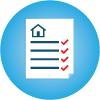 Copy birth certificates, marriage and divorce papers, adoption papers, social security cards, passports, driver?s licenses and pet microchip numbers, which, according to Just Great Lawyers, are necessary family documents to have at all times. For financial documents, bring tax information, financial account numbers, income verification, insurance information and information about bills and obligations. Necessary legal documents include wills, living wills, power of attorney documents, trust documents, titles and deeds to property you own and naturalization or citizenship documents (if you were not born in the U.S.). Bring medical documents like your insurance and immunization information, allergy information, medications list and any other crucial medical records. Keep these documents in a fireproof and waterproof safe or keep them in a binder. Consider keeping computer backup disks of the documents or storing some of them in an off-site location. If you do not keep these personal records with you, you will be at the mercy of the office that issued them to get new copies.
Copy birth certificates, marriage and divorce papers, adoption papers, social security cards, passports, driver?s licenses and pet microchip numbers, which, according to Just Great Lawyers, are necessary family documents to have at all times. For financial documents, bring tax information, financial account numbers, income verification, insurance information and information about bills and obligations. Necessary legal documents include wills, living wills, power of attorney documents, trust documents, titles and deeds to property you own and naturalization or citizenship documents (if you were not born in the U.S.). Bring medical documents like your insurance and immunization information, allergy information, medications list and any other crucial medical records. Keep these documents in a fireproof and waterproof safe or keep them in a binder. Consider keeping computer backup disks of the documents or storing some of them in an off-site location. If you do not keep these personal records with you, you will be at the mercy of the office that issued them to get new copies.
 Bring emergency contact information of family and friends so that you can stay in touch. USA.gov recommends you also sign up for alerts from the National Weather Service or getting the Federal Emergency Management Agency (FEMA) app on your phone for weather warnings and disaster, aid and shelter information.
Bring emergency contact information of family and friends so that you can stay in touch. USA.gov recommends you also sign up for alerts from the National Weather Service or getting the Federal Emergency Management Agency (FEMA) app on your phone for weather warnings and disaster, aid and shelter information.
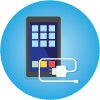 Bring cell phones and backup chargers that do not require electricity (such as solar-powered or battery-powered chargers). These will be necessary to receive alerts and contact others, if cell service is or becomes available.
Bring cell phones and backup chargers that do not require electricity (such as solar-powered or battery-powered chargers). These will be necessary to receive alerts and contact others, if cell service is or becomes available.
 Pack extra cash or have a savings account with enough money, depending on the size of your family, for a hotel, transportation or food if you are evacuated. Store cash in a fireproof and waterproof box or container. Do not assume that banks will be open or ATMs will be available. Nerdwallet recommends creating an emergency fund of around $500, if possible.
Pack extra cash or have a savings account with enough money, depending on the size of your family, for a hotel, transportation or food if you are evacuated. Store cash in a fireproof and waterproof box or container. Do not assume that banks will be open or ATMs will be available. Nerdwallet recommends creating an emergency fund of around $500, if possible.
The American Red Cross also recommends bringing an emergency blanket for warmth in case of a power outage, dangerously cold weather or simply for comfort. One blanket per person is ideal if you have the space and time to collect them in an evacuation.
 Bring maps of your area so that you can find your way around and to a safe location without relying on your phone or a GPS.
Bring maps of your area so that you can find your way around and to a safe location without relying on your phone or a GPS.
Power outage
Remember that in the event of a power outage, communications, water and transportation may be disrupted, according to Ready.gov. Food may be spoiled, and water could become contaminated.
 During an outage, keep freezers and refrigerators closed to keep your food as safe as possible. Use a thermometer in the refrigerator and freezer. When the power is restored, check the temperature. If it's above 40 degrees, throw out any meat, poultry, eggs, seafood or leftovers, as they will be unsafe, according to Electric Choice. Keeping canned foods in your pantry is always recommended as a back-up supply.
During an outage, keep freezers and refrigerators closed to keep your food as safe as possible. Use a thermometer in the refrigerator and freezer. When the power is restored, check the temperature. If it's above 40 degrees, throw out any meat, poultry, eggs, seafood or leftovers, as they will be unsafe, according to Electric Choice. Keeping canned foods in your pantry is always recommended as a back-up supply.
Do not use a gas stove to heat your home. Disconnect appliances and electronics to avoid damage that might be caused by electrical surges.
If necessary, create another plan to refrigerate medicine. Find out specific information for how long medications can be stored at higher temperatures, especially medications that are critical for life, according to Ready.gov.
If you have time, plan to have batteries and other alternatives to meet your everyday needs when the power goes out, especially during planned power outages such as those drafted by PG&E.
If heat or cold becomes extreme, go to a community location with power or consider going to an alternate location, if safe.
Earthquakes
Before an earthquake:
Before an earthquake, the Red Cross recommends picking safe places in each room of your home, workplace and/or school. This is the place you could go during a quake, such as under a piece of sturdy furniture or against an interior wall away from windows or any furniture that could fall on you.
Keep a flashlight and a comfortable pair of shoes by your bed (and each bed in your family). If an earthquake occurs in the dark or at night, you do not want to risk stepping on debris or not being able to see if you need to leave the room afterward.
Practice drop, cover and hold on in each of your safe spaces. During an earthquake, drop where you are onto your hands and knees. Then cover your head and neck with your arms and, if you can do so while avoiding an area with more debris, crawl to a safe space. Then hold on with one hand if you are under a table or desk.
If you are seated and unable to drop to the floor, bend forward, cover your head with your arms and hold on to your neck with both hands.
Ready.gov recommends the following if you are in a special situation and cannot find cover under a piece of furniture:
If you're in a vehicle, pull over, stop and set your parking brake. Avoid bridges and overpasses if possible. Keep your seatbelt fastened until the shaking stops. Drive carefully afterward and avoid bridges, ramps or overpasses that may have been damaged. If a power line falls on your vehicle, do not get out.
If you are in bed, turn face down. Cover your head and neck with a pillow.
Do not run outside. If you are outdoors, do not go inside and stay away from buildings.
Do not get in a doorway. They are no more stable than any other structure.
If you or your family member is in a wheelchair or is using a walker with a seat, lock the wheels and remain seated until the shaking stops. Protect your head and neck with your arms or anything available.
After an earthquake, follow these Ready.gov and Red Cross recommended precautions:
Check yourself for injuries and get first aid if necessary, first. Then check for injured or trapped people.
Stay alert for small fires. They are the most common hazard after an earthquake.
Assume aftershocks will follow. Drop, cover and hold on during each.
If you have to leave a building after the quake, use stairs, not an elevator, in case of power outages or aftershocks.
If you are trapped, protect your mouth, nose and eyes from dust. Do not shout, but send a text, bang on a pipe or wall or use a whistle to help rescuers locate you.
Only use phone calls during emergencies. Text will be more reliable.
Continue to listen to local news reports for emergency information and instructions. Wear protective clothing during clean-up and avoid removing heavy debris alone.
After the disaster, register yourself on the Red Cross? Safe and Well site to give your loved ones peace of mind. On this website, you can also search for loved ones.
Fires
To prepare for a wildfire, gather fire-specific emergency supplies, such as N95 respirator masks that filter particles in the air you breathe. Keep in mind issues with asthma or the needs of pets.
Pay attention to air quality alerts, such as the Air Quality Index on AirNow.
If possible, make sure your house number or address is clearly marked for rescuers? operations. Keep your lawn hydrated and remove dead vegetation from your gutters and roofs.
During the fire, follow authorities? instructions to evacuate, according to Ready.gov.
If you become trapped, call 911 and give your location. Emergency response may be delayed. Turn lights on to help rescuers find you.
If you are in smoky conditions but are not ordered to evacuate, stay inside in a safe location and do not use anything that burns, the Environmental Protection Agency recommends. Do not vacuum or smoke. Run your air conditioner to keep fresh air intake closed and the filter clean to prevent bringing additional smoke inside. Use the recycle mode on the air conditioner in your home or car, recommends the Red Cross.
The Red Cross adds to keep an eye on animals or pets, as hidden embers could burn them. Wet down debris to minimize breathing harmful particles. Wear gloves and sturdy shoes. Check for smoke and sparks in your neighborhood or home frequently. Wildfire winds can blow burning embers that may cause a fire.